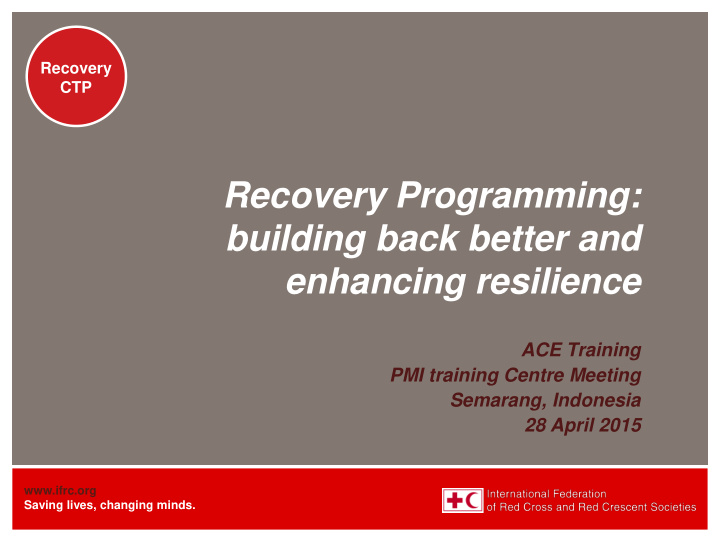



Recovery Recovery CTP CTP Recovery Programming: building back better and enhancing resilience ACE Training PMI training Centre Meeting Semarang, Indonesia 28 April 2015 www.ifrc.org Saving lives, changing minds.
Recovery CTP www.ifrc.org Saving lives, changing minds.
Recovery CTP www.ifrc.org Saving lives, changing minds.
Recovery CTP www.ifrc.org Saving lives, changing minds.
Recovery CTP www.ifrc.org Saving lives, changing minds.
Recovery Purpose of this session: CTP Know the concepts and key I. strategic issues of recovery. Highlight recovery examples from II. Indonesia and discuss other examples in the South East Asia. Present tools for developing III. operational strategies and designing recovery interventions. www.ifrc.org Saving lives, changing minds.
Recovery CTP www.ifrc.org Saving lives, changing minds.
Recovery A definition of early recovery: CTP Early recovery is the process of people’s lives returning to normal in the immediate aftermath of a disaster. It involves providing assistance to people in the earliest stages of disaster response in conjunction with the provision of relief, improving the effects of the relief and providing the basis for longer-term recovery. Early recovery enables people to participate more readily in longer-term recovery activities IFRC recovery programming guidance 2012 www.ifrc.org Saving lives, changing minds.
Recovery A definition of recovery CTP Recovery in the context of disaster response, is a process that results in people’s lives returning to normal in a way that they will be more resilient to future disasters. The extent to which people can recover after a disaster depends on the situation beforehand and how robust or resilient their resources are to withstand the effects of the disaster. For some, recovery will be relatively quick; for others it may take years. IFRC recovery programming guidance 2012 www.ifrc.org Saving lives, changing minds.
REMEMBER…….. Recovery CTP Individuals, communities and institutions begin to recover immediately after a disaster, relying on their own skills, experience and resources. www.ifrc.org Saving lives, changing minds.
Recovery CTP ‘Recovery programming’ is what external agencies do with the aim of supporting people as they recover from disasters. At its best: early recovery and recovery are based on good community-based programming principles and practices that may link to longer-term development. GTLL Disaster Recovery Tool Kit www.ifrc.org Saving lives, changing minds.
Recovery Examples of Recovery activities CTP Early recovery immediate support cash for work to remove the rubble materials for immediate shelter repair agricultural inputs to restart livelihoods protect remaining assets, avoid further loss providing psychological first aid to community members Recovery in the midterm reconstruction (houses, schools, health clinics, water supply systems) further strengthen livelihoods Restoring family links www.ifrc.org Saving lives, changing minds.
Recovery CTP www.ifrc.org Saving lives, changing minds.
Recovery In your table groups: CTP What factors determine the extent and speed people can recover? When does early recovery happen? List as many recovery responses as you can in 10 seconds. List 5 ‘ways of working’ for recovery programming. www.ifrc.org Saving lives, changing minds.
IFRC recovery “ways of working” Recovery CTP I. Participation of disaster-affected women, men, girls and boys, who have a right to determine their own future. II. Inclusive participation with equal involvement of members of the community regardless of age, sex, ethnicity & wealth. III. Being accountable to the affected communities, ensuring that affected populations can influence and participate in decision making concerning the operation. IV. Doing no harm either socially, economically or environmentally. V. Being timely and starting early to support and complement relief activities whenever possible. www.ifrc.org Saving lives, changing minds.
Recovery Strengthening recovery programming: CTP To build recovery thinking and approaches into disaster preparedness and response IFRC Recovery Guidance 2012 focuses on: applying key recovery principles and strategic issues assessment and response option analysis community participation building resilience and applying the ‘Do No Harm’ approach a multi-sector integrated approach & strong coordination use of innovative approaches (inc CTP and market support) www.ifrc.org Saving lives, changing minds.
Recovery Sinabung Volcano: Voucher distribution CTP Mount Sinabung volcano on Sumatra Island triggered the displacement of 28,715 people from 33 villages by January 14. In March it was decided to support the returning evacuees with necessary tools to clean up ash, repair roofs and work farm lands through a cash transfer pilot project. www.ifrc.org Saving lives, changing minds.
Recovery CTP www.ifrc.org Saving lives, changing minds.
Recovery Practical Innovation CTP Target area and beneficiary selection Adaptation of barcode-reading software Market survey Field training and simulation Socialization Voucher distribution and scanning Administration, finance and traders www.ifrc.org Saving lives, changing minds.
Recovery CTP Video www.ifrc.org Saving lives, changing minds.
Recommend
More recommend